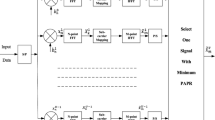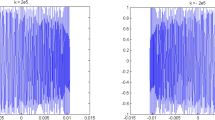Abstract
Due to the importance of weighted fractional Fourier transform (WFRFT) applications, it has become an important technology in the fields of OFDM and CDMA. Although the single parameter weighted fractional Fourier transform (SPWFRFT) is the most widely used method at present, the multiple-parameter weighted fractional Fourier transform (MPWFRFT) has received increasing attention in order to further improve the anti-scanning performance of the system. Thus, considering the characteristics of digital communications signals with the MPWFRFT, the anti-scanning method is investigated herein. By studying the process of the SPWFRFT, we establish the influence factors and calculate the weighted coefficients. Then, the influence factor is spread, and multiple parameters are added, which allow MPWFRFT processing to be studied in-depth. Based on this research, we carry out anti-scanning research under different conditions. By studying the relationship between the parameters M and V, the optimal parameter setting rules are given. Further, the bit error rate is discussed emphatically, and the minimum scanning interval of all parameters is given. In addition, we discuss the complexity and how to easily decode the useful signals at the receiver, and then the anti-scanning performance of MPWFRFT communication systems is proved.

































Similar content being viewed by others
References
Goel, N., & Singh, K. (2016). Convolution and correlation theorems for the offset fractional Fourier transform and its application. AEU—International Journal of Electronics and Communications,70(2), 138–150.
Zheng, L., Yang, C., Yan, C., & Qiu, H. (2018). Biorthogonal Fourier transform for multichirp-rate signal detection over dispersive wireless channel. EURASIP Journal on Wireless Communications and Networking,23, 1–13.
Ray, K. C., Prasad, M. V. N. V., & Dhar, A. S. (2017). An efficient VLSI architecture for computation of discrete fractional Fourier transform. Journal of Signal Processing Systems,2, 1–12.
Ma, L., Wu, Y., Zhuang, Z., & Liu, Y. (2018). A novel real-time Fourier and inverse Fourier transforming system based on non-uniform coupled-line phaser. AEU—International Journal of Electronics and Communications,94, 102–108.
Teng, W., Hao, H., Ran, T., & Yue, W. (2016). Security-coded OFDM system based on multiorder fractional Fourier transform. IEEE Communications Letters,20(12), 2474–2477.
Jahromi, M. S., Bagheri, V., Rostami, H., & Keshavarz, A. (2018). Feature extraction in fractional Fourier domain for classification of passive sonar signals. Journal of Signal Processing Systems,7, 1–10.
Singh, A. K., & Saxena, R. (2013). Doppler estimation from echo signal using FRFT. Wireless Personal Communications,72(1), 405–413.
Serbes, A., & Durak-Ata, L. (2010). Eigenvectors of the discrete Fourier transform based on the bilinear transform. EURASIP Journal on Advances in Signal Processing,6, 1–7.
Xin, Q., Xuejun, S., & Lin, M. (2012). Hybrid carrier spread spectrum system based on 4-weighted fractional Fourier transform. China Communications,9(1), 13–19.
Sha, X. J., Qiu, X., & Mei, L. (2012). Hybrid carrier CDMA communication system based on weighted-type fractional Fourier transform. IEEE Communications Letters,16(4), 432–435.
Mei, L., Zhang, Q., Sha, X., & Zhang, N. (2013). WFRFT precoding for narrowband interference suppression in DFT-based block transmission systems. IEEE Communications Letters,17(10), 1916–1919.
Fang, X., Sha, X., & Mei, L. (2015). Guaranteeing wireless communication secrecy via a WFRFT-based cooperative system. China Communications,12(9), 76–82.
Wang, Z., Mei, L., Sha, X., & Zhang, N. (2018). BER analysis of STBC hybrid carrier system based on WFRFT with frequency domain equalization. Science China Information Sciences,61(8), 082301.
Fang, X., Sha, X., & Li, Y. (2016). MP-WFRFT and constellation scrambling based physical layer security system. China Communications,13(2), 138–145.
Zhang, Z., Da, X., & Liu, H. (2017). A study of the covered characteristics of MAP-WFRFT satellite signals. Journal of Chongqing University of Posts and Telecommunications (Natural Science Edition),29(4), 460–467.
Yuan, L., Da, X., Xu, R., & Ni, L. (2018). Design of constellation precoding in MP-WFRFT based system for covert communications. Journal of Huazhong University of Science and Technology (Natural Science Edition),46(2), 72–78.
Liang, Y., Da, X., Xu, R., et al. (2018). Analysis on constellation splitting of 8PSK in MP-WFRFT-based systems. Advanced Engineering Sciences,50(4), 179–185.
Lang, J., Tao, R., Ran, Q., & Wang, Y. (2008). The multiple-parameter fractional Fourier transform. Science China Information Sciences,51(8), 1010–1024.
Liu, F. (2018). A cross-hierarchical scanning method based SP-4-WFRFT for digital communication signals. Mathematical Problems in Engineering,8, 1–9.
Funding
This work is supported in part by the National Natural Science Foundation of China (Grant No. 61501309), the China Postdoctoral Science Foundation (Grant No. 2017T100185), the Liaoning Natural Science Foundation of China (Grant No. 2017011002-301), and Liaoning Provincial Colleges and Universities Innovative Talents Support Program.
Author information
Authors and Affiliations
Corresponding author
Ethics declarations
Conflict of interest
The authors declare that they have no competing interests.
Additional information
Publisher's Note
Springer Nature remains neutral with regard to jurisdictional claims in published maps and institutional affiliations.
Rights and permissions
About this article
Cite this article
Liu, F., Feng, Y. Anti-scanning research for MPWFRFT communication signals. Wireless Netw 26, 723–737 (2020). https://doi.org/10.1007/s11276-019-02175-4
Published:
Issue Date:
DOI: https://doi.org/10.1007/s11276-019-02175-4




